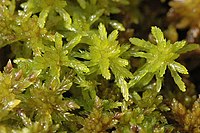
Photo from wikipedia
ABSTRACT Palaeoecology has been prominent in studies of environmental change during the Holocene epoch in Scotland. These studies have been dominated by palynology (pollen, spore and related bio-and litho-stratigraphic analyses)… Click to show full abstract
ABSTRACT Palaeoecology has been prominent in studies of environmental change during the Holocene epoch in Scotland. These studies have been dominated by palynology (pollen, spore and related bio-and litho-stratigraphic analyses) as a key approach to multi- and inter-disciplinary investigations of topics such as vegetation, climate and landscape change. This paper highlights some key dimensions of the pollen- and vegetation-based archive, with a focus upon woodland dynamics, blanket peat, human impacts, biodiversity and conservation. Following a brief discussion of chronological, climatic, faunal and landscape contexts, the migration, survival and nature of the woodland cover through time is assessed, emphasising its time-transgressiveness and altitudinal variation. While agriculture led to the demise of woodland in lowland areas of the south and east, the spread of blanket peat was especially a phenomenon of the north and west, including the Western and Northern Isles. Almost a quarter of Scotland is covered by blanket peat and the cause(s) of its spread continue(s) to evoke recourse to climatic, topographic, pedogenic, hydrological, biotic or anthropogenic influences, while we remain insufficiently knowledgeable about the timing of the formation processes. Humans have been implicated in vegetational change throughout the Holocene, with prehistoric woodland removal, woodland management, agricultural impacts arising from arable and pastoral activities, potential heathland development and afforestation. The viability of many current vegetation communities remains a concern, in that Scottish data show reductions in plant diversity over the last 400 years, which recent conservation efforts have yet to reverse. Palaeoecological evidence can be used to test whether conservation baselines and restoration targets are appropriate to longer-term ecosystem variability and can help identify when modern conditions have no past analogues.
Journal Title: Earth and Environmental Science Transactions of the Royal Society of Edinburgh
Year Published: 2019
Link to full text (if available)
Share on Social Media: Sign Up to like & get
recommendations!